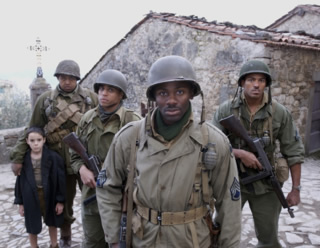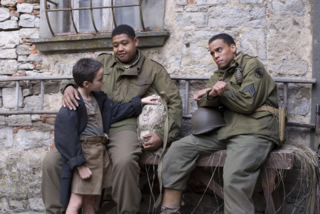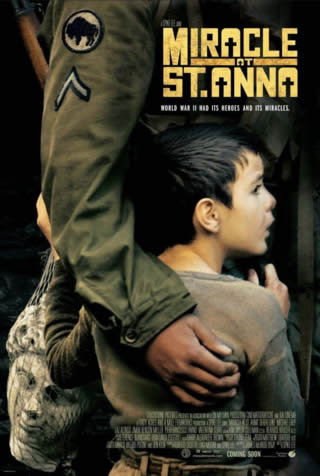Movies

New Releases • A-D • E-H • I-P • Q-Z • Articles • Festivals • Interviews • Dark Knight • Indiana Jones • John Wick • MCU
Miracle at St. Anna
Directed by Spike Lee
Rated R
Miracle at St. Anna is a Spike Lee Joint that serves Fellini wine. But it skips the lightheaded buzz and goes straight for the headache.
Marblehead Murderer

Men of war.

Angelo, Train, Bishop - and a marblehead.
Photos: Touchstone
The movie starts off strong and with loads of potential. It's 1983, the location: a Harlem post office. A man asks for a 20-cent stamp and the guy behind the counter goes postal. He kills the customer with a German Lugar stashed at his desk.
Why would this quiet gentleman, Hector Negron (Laz Alonso, Jarhead), kill the man? The killer has no known enemies, is only three months from retirement, widowed, and earned a Purple Heart while serving for four years in the army during World War II.
Compounding the mystery, when police search Hector's apartment they find an antique marble statue head in a Macy's bag stashed in his closet. A gung-ho journalist anxious to get out of his newspaper's obits department visits Hector in prison and asks him what it's all about.
The murder and the statue's head are inexorably linked together for Hector. The bulk of the movie shifts back to 1944 and recreates the events that ultimately led, 39 years later, to cold-blooded murder.
Opportunity Lost
Several months ago there was much ado about Spike Lee (Inside Man)ripping on Clint Eastwood for his failure to include black soldiers in Flags of Our Fathers. Eastwood pointed out that, historically speaking, no black soldiers were involved in the mission his movie depicted. Then Eastwood put an end to the tiff with some kind of dismissive comment along the lines of "buzz off."
Well, if Miracle at St. Anna is Spike's idea of a cinematic response to Flags of Our Fathers, he's really done himself a tremendous disservice. It could be argued that, if it weren't for the fact that Spike directed this hodge-podge, the movie's portrayal of many of the black soldiers would've stoked Spike's ire.
Most irritating is a lothario, Bishop Cummings (Michael Ealy, Barbershop), who tends to think with his anatomy more than anything else. There's also a simple-minded, good-natured gentle giant, Sam Train (Omar Benson Miller, Things We Lost in the Fire), repeatedly referred to by a young Italian boy as the "Chocolate Giant." He's really likeable, in the same way Bubba was charming in Forrest Gump.
The other soldiers aren't all that appealing and certainly aren't given all that much to do, aside from snipping about the injustices back home even as they risk their lives on the frontline. On the one hand, they're taunted by Axis Sally's propaganda being seductively spit out over loudspeakers surrounding a strategic river crossing, on the other hand, they're harassed and belittled by their white commanding officers.
As for the main protagonist, Hector, he's the sharpest of the bunch, a man who speaks Italian and seeks understanding of his surroundings, but, as it happens, he's not African-American, he's Puerto Rican.
Pilgrim's Progress
To Spike's credit, Miracle at St. Anna has a lot on its mind. There are the expected racial tensions as black soldiers fight – and die – for a country whose level of reciprocation is debatable. There's also quite a bit of material about faith and, of course, war and its brutal bloodshed. Thanks to the lothario, there's also a little sex thrown in for good measure.
Trouble is, this all adds up to much, much less than Spike's grand aspirations would hope thanks in large part to a bizarre sense of humor that simply doesn't gel with the movie's overall dark tone. Perhaps the intent was to create something along the lines of Life Is Beautiful, the Holocaust movie starring the irrepressible Roberto Benigni. Alas, when characters die – then don't die – Miracle at St. Anna stops being a war movie and turns into something more like Pay It Forward Part Due.

Spike moves from one vignette to the next, calling to mind the episodic nature of Saving Private Ryan. That storytelling fashion does afford him some really good moments, such as the very effective opening sequence and a scene in which the black soldiers tear down fascist propaganda posters pasted on a wall in an Italian village. Nice, sincere scenes between Train and the Italian boy, Angelo (Matteo Sciabordi in an excellent debut performance), are full of sweetness and genuine humanity.
Even so, there's nothing here that comes close to Ryan's classic "earn this" finale. The closest this movie comes to greatness is via its opening clips of John Wayne in The Longest Day.
The Bells of St. Anna
At the core of Miracle at St. Anna is a serious question that is never actually raised during the movie. If Hector had killed his victim back in the little Italian village in 1944, it would be a non-issue. Should he be held accountable for doing the deed 39 years later, in the post office?
Instead of tackling that question head on, the story (James McBride wrote the screenplay based on his own book), relies on miracles to create a sense of mysticism and destiny.
Miracles can be used as a cinematic device to evoke wonder, question faith and existence, and reinforce mankind's relative insignificance in the universe. But even so, there is always the danger of it all turning into hogwash.
Unfortunately, that's the primary impact of Miracle at St. Anna. Even with its sometimes gripping wartime backdrop, the miracles – plural – that drive this highly ambitious story come across as a load of hogwash. The movie's conclusion comes out of nowhere with a speech about safety devices, car seat belts, an unlikely billionaire, and the argument that "miracles are the only sure thing in life."
An unlikely mish-mash, this one's best left to those who like their feel-good hokum served up with large doses of profanity and on-screen violence. If this movie can find an audience like that, then it'll be a real miracle.
• Originally published at MovieHabit.com.


